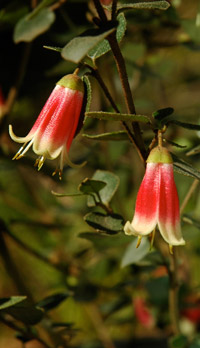Spring 2013 - Issue 7
Winter 2013 - Issue 6
Autumn 2013 - Issue 5
Summer 2012/2013 - Issue 4
Spring 2012 - Issue 3
Winter 2012 - Issue 2
Autumn 2012 - Issue 1
Exhibition uncovers the Red Centre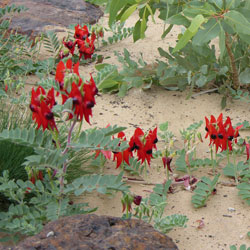
As a precursor to the opening of the Red Centre Garden, the Australian National Botanic Gardens is presenting a special exhibition, Uncovering the Red Centre.
Exploring the iconic plants, Aboriginal culture and colourful history of Central Australia, Uncovering the Red Centre features the plant stories ofthis dramatic landscape.
“We’re all very excited about the opening of our new Red Centre Garden, but just as exciting and equally as important are the stories, the people and the journey behind the Red Centre Garden’s creation,” Dr Judy West, Executive Director of the Gardens said.
“We wanted to share our ideas, inspirations and stories behind the development of the Red Centre Garden and bring this alive, so we created an exhibition which does exactly that.”
Based on the concept 'boom and bust', the exhibition demonstrates how plants have adapted to the dry and arid environment.
“Visitors to the exhibition will be able to truly appreciate the diversity of plants growing in one of Australia’s harshest environments,” Dr West said.
The Uncovering the Red Centre exhibition also pays tribute to the rich cultural life of central Australian Aboriginal people.
“Through the exhibition, we take a look at the hundreds of Aboriginal female artists from 28 remote communities across the Western and Central Deserts of Australia and at Tjanpi - an organisation that empowers women of the desert to generate an income by creating artworks from endemic grasses,” Dr West said.
“Also on display is an original painting by Aboriginal artist, Teresa Purla McKinnon, whose artwork has been incorporated into a significant public art commission at the Red Centre Garden.
“We are also screening a documentary of the construction of the Red Centre Garden, as well as displaying materials used to recreate this iconic national landscape right here in Canberra.”
The Uncovering the Red Centre exhibition is on display at the Australian National Botanic Gardens Visitor Centre Galley until Sunday 10 November 2013. Entry to the exhibition is free and is open daily from 9.30 am – 4.30 pm.
The Red Centre Garden will open to the public during the Gardens’ Bush Capital Celebration event on 2 and 3 November 2013. This event is part of Canberra’s Centenary celebrations.
Working together to save the Ginninderra Peppercress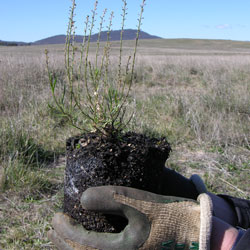
A large team from the Australian National Botanic Gardens, the ACT Government, Greening Australia and local volunteers accomplished its mission to plant more than a thousand endangered Ginninderra Peppercress (Lepidium ginninderrense).
Listed as vulnerable nationally and endangered in the ACT, the Ginninderra Peppercress only grows in small parts of Lawson and Mitchell – two suburbs of Canberra - in a combined area of just 300 square metres.
Through this planting mission, the Ginninderra Peppercress was, for the first time, translocated into the wild and across two new sites in Canberra – Crace and Dunlop, providing insurance against events such as bushfire, prolonged drought or human activities that may damage remaining wild populations.
The project is a partnership between the Environment and Sustainable Development Directorate, the Territory and Municipal Services Directorate, the Australian National Botanic Gardens, the Australian Government and Greening Australia.
The Ginninderra Peppercress is a perennial herb and member of the mustard family. It grows to a height of about 20 cm, with one to six branched stems arising from the rootstock.

An intriguing display of orchids
Over 2000 visitors caught a rare glimpse of the Gardens' research collection of native Dendrobium orchids when we recently opened our Research Glasshouse to the public.
Usually open only to researchers, the Gardens’ Research Glasshouse was bursting with the fragrance and colour of hundreds of cool temperate orchids of the species Dendrobium speciosum.
“We were absolutely amazed at how prolifically the Dendrobium speciosum flowered this year. The orchids in our Research Glasshouse are from our research collection used for genetic analysis. They only flower in this way every few years, and this year's flowering was particularly exceptional,” Orchid Research Scientist Dr Mark Clements said.
Also known as the rock lily, Dendrobium speciosum is found in varying habitats along 3000 kilometres of Australia’s eastern coastline. It usually grows on branches of rainforest trees or on sandstone in open forest.
“We are very fortunate to have such a diverse collection of this orchid right here in the Gardens,” Dr Clements said.
“Until recently, taxonomists have had a hard time agreeing whether Dendrobium speciosum should be classified as many different species and differentiating between its forms.
"These orchids were used as specimens for genetic analysis that has helped in understanding the classification of Dendrobium speciosum. We have recently discovered the orchid is one species with two distinct subspecies."
The Australian National Botanic Gardens' Orchid Research Group is based at the Centre for Australian National Biodiversity Research. Their mission is to collect, classify and conserve native orchids.
The Centre for Australian National Biodiversity Research is a collaboration between the Australian National Botanic Gardens and CSIRO’s Division of Plant Industry.
Blooming success for rare species 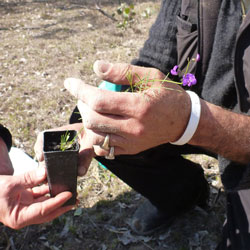
The Australian National Botanic Gardens and its partner ACTEW Water are working together again to help save the endangered small purple pea, Swainsona recta.
In June 2012, the Gardens and ACTEW embarked on a mission to help protect the endangered pea by collecting Swainsona recta seed, germinating them and then successfully planting seedlings around the Williamsdale region.
“We have always recognised the importance of protecting the small purple pea and I’m pleased that we are able to contribute to its survival through our continued support of this project,” ACTEW’s Group Manager Environment, Kirilly Dickson said.
Staff at the Australian National Botanic Gardens are also pleased with the results so far.
“We are delighted to see how well the 70 purple peas are doing in their first year. Not only are they flowering profusely, but they’re also producing healthy seed that we are able to collect and bank safely in the National Seed Bank,” Curator of Living Collections David Taylor said.
“We planted an additional 30 plants in the same Williamsdale area – collected from seed at a nearby location. Our aim with this new planting is to enrich the genetic diversity of this nationally listed threatened species.”
The Gardens will be monitoring and documenting the success of the planting by recording, storing and sharing data for future research.
“We want to ensure the plant’s best chance for survival, so we test the seeds for viability, select seedlings originating from specific populations for planting and record data for further study,” David said.
“We then feed this information through to other institutions who are working to save Swainsona recta.”
The Australian National Botanic Gardens is home to a large and ever-increasing collection of Australian native seeds and contributes to safeguarding Australian plant species from extinction.
Gardens gives rare local plant a lifeline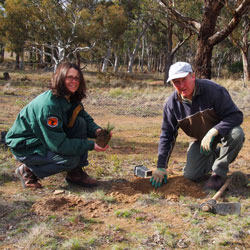
A rare plant discovered growing in New South Wales only five years ago will have a better chance at survival thanks to the Australian National Botanic Gardens and the New South Wales Office of Environment and Heritage.
The Gardens’ nursery propagated eight Large-fruit Groundsel, Senecio macrocarpus, from two parent plants discovered growing on a New South Wales property near the ACT.
These two plants are the only individuals of Large-fruit Groundsel known to occur in New South Wales.
The Large-fruit Groundsel is a small perennial daisy endemic to south-eastern Australia. Considered extinct in Tasmania, the groundsel was thought to persist only in South Australia and Victoria until its discovery in New South Wales.
“Although there are an estimated 36,000 Large-fruit Groundsel plants growing in 15 populations across Victoria and South Australia, most plants are confined to a single population at Messent Conservation Park near Salt Creek in South Australia,” said David Taylor, the Gardens' Curator of Living Collections.
“We hope to establish a new population as insurance against the plant’s disappearance.
“With the help of the New South Wales Office of Environment and Heritage we will now transplant the eight plants propagated by Gardens’ staff. We’ll be planting them at the Mcleods Creek Nature Reserve, close to the location where the two parent plants were discovered.
Seed has also been conserved in the Gardens’ National Seed Bank.”
Major threats to the plant include habitat disturbance and destruction, weed invasion and competition. The species is listed as vulnerable under the Commonwealth Environment Protection and Biodiversity Conservation Act 1999.
The Large-fruit Groundsel is just one of several plants that the Australian National Botanic Gardens is working to conserve, as part of its aim to protect Australia's unique biodiversity.
Floresco in the Gardens shows new shades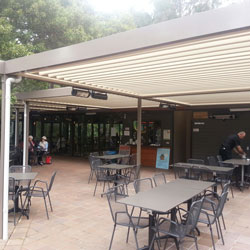
Dining alfresco at Floresco in the Gardens cafe has just gotten better. New louvered awnings have been installed to enhance the outdoor dining experience at Floresco.
The new louvered roof can open to let sun in during winter and close to keep the rain out. They have the added advantage that they allow for lighting and heating to warm patrons during cool Canberra evenings. They increase the covered outdoor seating capacity for functions at the cafe.
![Director of National Parks [logo]](../../../images/dnp_90px.gif)





